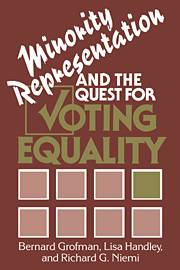Book contents
- Frontmatter
- Contents
- Acknowledgments
- List of Tables
- Introduction
- 1 The Right to Vote and the Right to Representation
- 2 The Evolution of a Vote Dilution Standard Through 1986
- 3 The Vote Dilution Standard in the Post-Gingles Era: Clarifications and Complications in the Lower Courts
- 4 Defining and Measuring Racially Polarized Voting and Other Elements of the Totality of the Circumstances
- 5 Vote Dilution in Single-Member Districts and Other Issues of the 1990s
- 6 The Voting Rights Act and the Realistic Politics of Second Best: An Optimistic Look to the Future
- Notes
- References
- Index of cases
- Index
6 - The Voting Rights Act and the Realistic Politics of Second Best: An Optimistic Look to the Future
Published online by Cambridge University Press: 18 March 2010
- Frontmatter
- Contents
- Acknowledgments
- List of Tables
- Introduction
- 1 The Right to Vote and the Right to Representation
- 2 The Evolution of a Vote Dilution Standard Through 1986
- 3 The Vote Dilution Standard in the Post-Gingles Era: Clarifications and Complications in the Lower Courts
- 4 Defining and Measuring Racially Polarized Voting and Other Elements of the Totality of the Circumstances
- 5 Vote Dilution in Single-Member Districts and Other Issues of the 1990s
- 6 The Voting Rights Act and the Realistic Politics of Second Best: An Optimistic Look to the Future
- Notes
- References
- Index of cases
- Index
Summary
In the previous chapters we have largely limited ourselves to descriptions of existing case law and closely related, unresolved issues. Yet the development of this case law – especially the expansive interpretation of Section 2 of the amended Voting Rights Act – has been highly criticized (Butler, 1990; Graham, 1992; O'Rourke, 1992; Thernstrom, 1987), and the continuing stream of decisions, dealing with less obviously racially motivated and racially dilutive election systems and laws, is likely to be even more controversial.
If there has been less public discussion of representation than of other areas of race relations, such as the use and interpretation of test scores or access to jobs and promotions, it is because districting is much less visible to the average person. But matters of representation are arguably more fundamental to the future of our country than are issues that have grabbed the most attention, for the resolution of those policy issues, as well as the legitimacy of the government itself, hinge in part on the composition of our representative bodies. With this in mind, we turn our attention in this chapter to normative aspects of the Voting Rights Act and its interpretation in the courts.
Legislative intent and the right to vote versus the right to representation
The application of the Voting Rights Act to matters of representation has sometimes been challenged as inappropriate, on the grounds that its use against vote dilution was never fully debated and never sanctioned by Congress.
Information
- Type
- Chapter
- Information
- Minority Representation and the Quest for Voting Equality , pp. 129 - 137Publisher: Cambridge University PressPrint publication year: 1992
